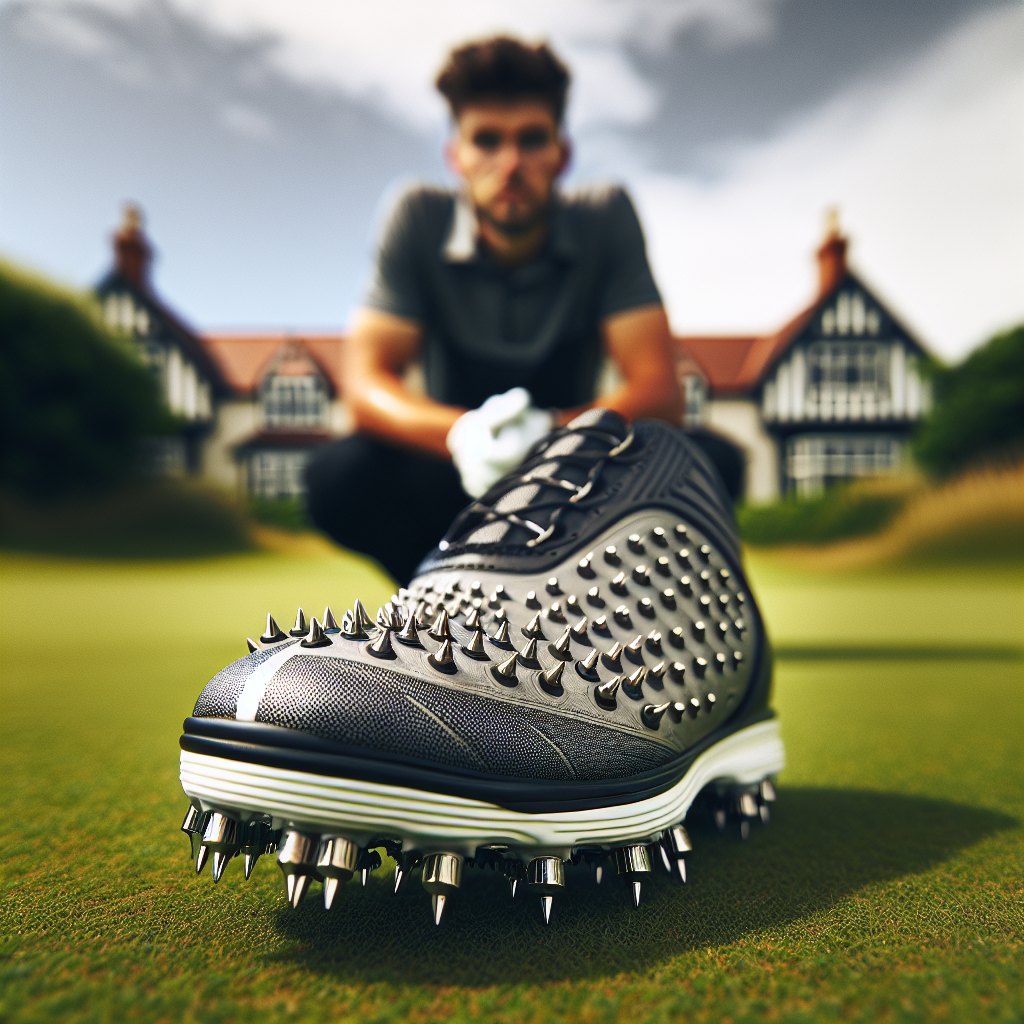
Imagine stepping onto the lush green fairway of your favorite golf course, the sun warming your skin as you grip your club tightly. As you prepare to tee off, a nagging question crosses your mind: are there any restrictions on the type of golf shoes allowed on this course? It seems like a small detail, but it could make all the difference in your swing and overall performance. In this article, we will explore whether golf courses are imposing regulations on the type of golf shoes players can wear. Get ready to uncover the secrets behind the perfect footwear for the perfect swing.
History of Golf Shoes Regulations
Early Years of Golf Shoes
In the early years of golf, there were no specific regulations regarding the type of shoes that could be worn on the course. Players would often wear their everyday shoes, which were often made of leather and had smooth soles. While these shoes provided some traction on the grass, they were not ideal for the sport, as players often found themselves slipping and losing balance during their swings. As the popularity of golf grew and the sport became more organized, the need for regulations regarding appropriate footwear became evident.
Increase in Golf Course Regulations
As golf courses started to increase in number and size, the need to regulate the type of golf shoes allowed on the courses became imperative. Golf course owners and managers realized that certain types of shoes could cause damage to the course, affecting the overall playing conditions and requiring expensive maintenance. To address this issue, regulations were put in place to ensure that golfers wore appropriate shoes that minimized the impact on the course.
Factors Influencing Golf Shoe Regulations
Growth of Golf Course Maintenance Costs
One of the main factors that influenced the implementation of golf shoe regulations was the increasing cost of golf course maintenance. Golf courses require significant upkeep to maintain their pristine conditions, and the wrong choice of shoes can contribute to the deterioration of the grass and the overall playing surface. By regulating the type of golf shoes allowed, golf courses can minimize the damage caused and reduce the need for extensive maintenance, ultimately saving costs.
Improvements in Golf Shoe Technology
Advancements in golf shoe technology have also played a significant role in the development of regulations. The introduction of new materials, such as rubber and synthetic compounds, has allowed for the creation of golf shoes that provide better traction and stability on the course. These technological advancements have led to the emergence of different types of golf shoes, each designed to enhance performance and comfort. However, with the variety of options available, regulations are needed to ensure that golfers choose shoes that meet specific standards.
Environmental Concerns
With growing awareness of environmental conservation, golf shoe regulations have also taken into consideration the impact on the environment. The choice of materials used in golf shoes can affect the course’s ecosystem, particularly if they contain harmful substances or are not biodegradable. Golf shoe regulations aim to promote the use of environmentally-friendly materials that minimize the ecological footprint of the sport.
Different Types of Golf Shoes
Traditional Spiked Golf Shoes
Traditional spiked golf shoes have been a popular choice among golfers for many years. These shoes feature removable spikes on the soles, typically made of metal or plastic, which provide excellent traction on the grass. The spikes can be changed depending on the playing conditions, allowing golfers to customize their shoes based on the course’s demands. However, the use of traditional spiked golf shoes may cause damage to the course, which has led some golf courses to restrict their use.
Spikeless Golf Shoes
Spikeless golf shoes have gained popularity in recent years due to their versatility and comfort. Instead of removable spikes, spikeless shoes are designed with built-in traction elements on the soles, such as rubber nubs or dimples. These shoes offer good grip on the grass while eliminating the risk of damaging the course. Spikeless golf shoes also provide the advantage of being suitable for both on-course play and off-course activities, making them a convenient choice for many golfers.
Hybrid Golf Shoes
Hybrid golf shoes combine the features of both traditional spiked and spikeless golf shoes. They feature removable spikes that can be screwed into the soles when needed, providing the golfer with the flexibility to adjust the shoe’s traction based on the playing conditions. Hybrid golf shoes offer a middle ground for golfers who desire the stability of traditional spiked shoes on certain courses but want the versatility and comfort of spikeless shoes on others.
Golf Sandals
Golf sandals are a more casual option for golfers who prioritize comfort and breathability. These shoes are designed with open-toe and open-heel designs, providing maximum airflow to the feet. Golf sandals typically have a modified sole with traction elements to ensure stability during swings and walks on the course. While not suitable for all playing conditions, golf sandals offer a unique option for golfers looking for a relaxed and comfortable experience on the course.
Impact of Golf Shoe Regulations on Players
Enhancing Performance and Comfort
Golf shoe regulations have a significant impact on players’ performance and comfort on the course. By specifying the types of shoes allowed, course owners and managers aim to ensure that golfers have the best footwear to support their swings and movements. Well-designed golf shoes provide stability, grip, and cushioning, allowing players to maintain their balance and transfer power effectively. Regulations that encourage the use of high-quality and technologically advanced shoes ultimately lead to enhanced performance and improved overall experience for golfers.
Adapting to Different Playing Conditions
Golf courses are not all created equal, and their playing conditions can vary greatly. From dry and firm courses to wet and muddy terrains, each course presents unique challenges that golfers must navigate. Golf shoe regulations help players adapt to these different playing conditions by specifying the appropriate types of shoes to be worn. For example, spiked shoes may be required on courses with soft or wet soil to ensure traction, while spikeless or hybrid shoes may be more suitable for dry and firm courses.
Common Regulations Imposed by Golf Courses
Spikes Allowed vs. Spikeless Only
One of the most common regulations imposed by golf courses is the decision between allowing spiked shoes or requiring spikeless shoes only. Courses that permit spiked shoes often have specific requirements regarding the type and length of spikes allowed to minimize damage to the course. On the other hand, courses that enforce a spikeless-only policy aim to protect the turf from potential harm caused by spikes.
Allowed Spike Types
For courses that allow spiked shoes, there are typically regulations regarding the type of spikes that can be used. Metal and plastic spikes are the most common options, each offering different advantages and drawbacks. Metal spikes provide excellent traction but may cause more damage to the course, while plastic spikes are less likely to harm the turf but may not provide the same level of grip.
Minimum Spike Length
To prevent excessive damage to the course, some golf courses specify a minimum spike length for the shoes allowed. This regulation ensures that the spikes penetrate the grass enough to provide traction but are not too long that they cause unnecessary harm. Typically, courses with softer soil or more delicate grass require longer spikes, while courses with firmer ground can have shorter spike length requirements.
Maximum Spike Length
Similarly, golf courses may set a maximum spike length to prevent excessive damage caused by long spikes. This regulation aims to strike a balance between providing traction and preserving the course’s integrity. Golfers must ensure that their spikes do not exceed the specified maximum length to comply with the regulations.
Spike Material Restrictions
In addition to regulations regarding spike length, some golf courses may impose restrictions on spike materials. This is particularly relevant for traditional spiked shoes, as certain materials can cause more damage to the course than others. By specifying the materials allowed, golf courses ensure that golfers are not using spikes that may harm the turf or pose a safety risk to themselves and others.
Benefits of Regulating Golf Shoes
Preserving Course Conditions
One of the primary benefits of regulating golf shoes is the preservation of course conditions. Golf courses invest significant time, effort, and resources in maintaining the quality of their playing surfaces. By enforcing regulations on the type of shoes allowed, course owners can minimize the damage caused by inappropriate footwear and preserve the integrity of the turf. This, in turn, ensures a consistently high-quality playing experience for all golfers.
Reducing Maintenance Costs
Regulating golf shoes can also have financial benefits for golf course owners. By preventing damage to the course caused by improper shoes, maintenance costs can be significantly reduced. Repairing divots, reseeding damaged areas, and maintaining the overall appearance of the course can be expensive endeavors. Through appropriate regulations, golf courses can mitigate these costs and allocate their resources more efficiently towards improving other aspects of the course.
Improving Safety for Players
Safety is a paramount concern for golf courses, and regulating golf shoes helps ensure the well-being of players. Proper footwear with suitable traction reduces the risk of slipping and falling, especially in wet or uneven conditions. By implementing regulations that promote the use of shoes designed for golf, courses can create a safer environment for golfers to enjoy the game without unnecessary hazards.
Challenges in Regulating Golf Shoes
Standardization Across Courses
One of the challenges in regulating golf shoes is achieving standardization across different courses. Golf courses vary in their preferences, requirements, and playing conditions, making it difficult to establish uniform regulations. While common guidelines can be implemented, there may still be variations between courses, causing confusion and inconvenience for golfers who play in different locations. Efforts to establish industry-wide standards for golf shoe regulations are ongoing but face inherent complexities due to the diverse nature of golf courses.
Player Resistance and Preferences
Players often have personal preferences when it comes to their choice of golf shoes. Some golfers may be resistant to certain regulations, particularly if they prefer a particular type or brand of shoes that may not comply with the course’s guidelines. Balancing player preferences with the need for regulations can be challenging, as both factors must be considered to ensure a fair and enjoyable experience for all golfers.
Enforcement Difficulties
Enforcing golf shoe regulations can prove to be a logistical challenge. Course staff must monitor and ensure compliance with the regulations, which can be time-consuming and require additional resources. Educating players about the importance of adhering to the regulations and the potential consequences of non-compliance is crucial. Furthermore, effective enforcement requires consistent communication, monitoring, and clear consequences for those who do not comply.
Notable Golf Courses with Strict Shoe Regulations
Augusta National Golf Club
Augusta National Golf Club is renowned for its strict regulations regarding golf shoes. The club strictly enforces a spikeless-only policy to protect the course’s delicate grass and maintain its pristine conditions. Players who wish to compete or play a round at Augusta National must comply with these regulations, ensuring that the course remains in top-notch shape.
St. Andrews Links
St. Andrews Links, considered the home of golf, also has notable shoe regulations in place. The Old Course, in particular, requires golfers to wear spikeless shoes to prevent any potential harm to the course. As one of the oldest and most prestigious courses in the world, St. Andrews is committed to preserving its historical and natural beauty, and proper footwear plays a crucial role in achieving this.
Pebble Beach Golf Links
Pebble Beach Golf Links, situated along the stunning California coastline, has its own set of shoe regulations. The course allows both traditional spiked and spikeless shoes but specifies the type and length of spikes that can be used. By carefully managing the types of shoes allowed, Pebble Beach strives to maintain excellent course conditions while offering options for golfers based on their preferences and playing needs.
Evolution of Golf Shoe Regulations
Transition from Traditional to Spikeless Shoes
Over the years, there has been a noticeable transition from traditional spiked golf shoes to spikeless options. This shift is largely influenced by the desire to minimize damage to the course and provide golfers with increased comfort and versatility. The evolution of golf shoe technology and the development of spikeless options have given golfers more choices while balancing the needs of the golf course.
Ongoing Innovation in Golf Shoe Design
Golf shoe regulations continue to evolve as advancements in shoe design and technology emerge. Manufacturers are constantly innovating to create golf shoes that offer superior performance, comfort, and traction. New materials, cushioning systems, and tread designs are being incorporated into golf shoes to enhance grip, reduce fatigue, and improve overall functionality. As these innovations continue to reshape the golf shoe market, regulations will likely adapt to accommodate new designs and features.
Conclusion
Golf shoe regulations play a crucial role in the sport, ensuring the preservation of course conditions, reducing maintenance costs, and improving safety for players. Golf courses must carefully consider factors such as maintenance costs, technological advancements, and environmental concerns when adopting and enforcing shoe regulations. While there are challenges to achieving standardization and balancing player preferences, the benefits of regulating golf shoes outweigh these obstacles. As golf shoe technology continues to evolve, so too will the regulations, ensuring that golfers can continue to enjoy the sport with optimal footwear that supports their performance and protects the courses they play on.





